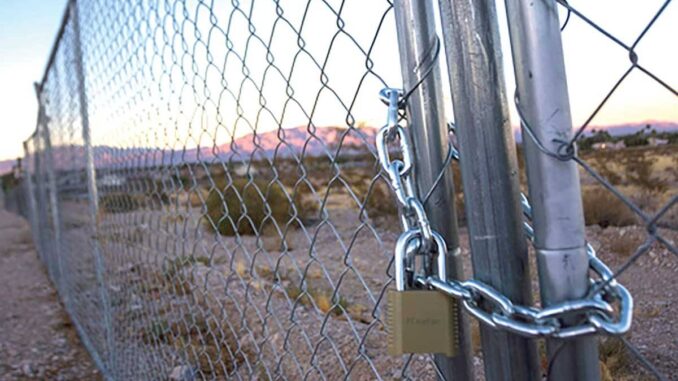
SOME US parts are resisting the historic building boom of big, bright temples of the Church of Jesus Christ of Latter-day Saints, also known as the Mormon faith.
In Las Vegas, homeowners in a rural foothills neighborhood complain the size and lighting of a temple that won city approval will forever change the environment. Some feel trampled, believing church and city officials rushed to approve the project. ” … It soured people’s taste to see how they steamrolled the neighborhood,” said homeowner Matthew DeLoe.
Most temples the faith built have been well received, but the Las Vegas fight mirrors objections over construction plans in Texas, Wyoming and the religion’s home state of Utah. Officials insist they consult with locals and carefully design temples for each environment. The battles are forcing the church to explain to non-members why the lavish temples are so vital to their beliefs.
A construction fence secures the site where The Church of Jesus Christ of Latter-day Saints plans to build a new temple near Las Vegas, Sept. 27, 2024.
PHOTO BY TY ONEIL/AP
Church spokesmen say the temples draw their faithful closer to God, and they are places for sacred ceremonies, such as weddings sealing couples for eternity and baptisms bringing deceased family members into the fold. Temples are separate from the church’s 20,000 worldwide meetinghouses, which welcome everyone and gather members for Sunday services. They allow only devout members who follow church rules inside.
Thousands of supporters and opponents packed planning meetings for months before the Las Vegas City Council unanimously approved a three-story temple in July. Larger than the Notre Dame Cathedral in Paris, its golden steeple will soar nearly 200 feet.
Some who want to sue to stop the project insist their concerns have nothing to do with the faith’s religious teachings, which include eternal families, tight-knit congregations, and bans on alcohol, coffee, gambling and same-sex relationships. Sue Kristensen of the Nevada Rural Preservation Alliance says the problem is the building’s size: “It’s blocking everyone’s views of beautiful Lone Mountain. Monstrosity is the best word that I can think of.”
Church officials like spokesman Doug Andersen have another description for the more than 300 temples built recently: ” … Clean, and beautiful, and quiet, as are the people who will frequent these sacred spaces.”
New temple projects could be announced at this weekend’s twice-a-year church conference, where congregants of the 17.2-million-member faith gather in person in Salt Lake City or watch online. What the faithful won’t hear is the cost of the elaborately built temples. The church declines to disclose construction figures, but its investment arm has a portfolio worth nearly $55 billion, according to its most recent US Securities and Exchange Commission (SEC) disclosures.
Test case
The SEC fined the church and its money management arm $5 million in February 2023 for using shell companies to obscure the size of the church’s financial holdings. Scrutiny focused on whether the tax-exempt faith sits atop a treasure trove of wealth. The government noted the church was concerned that disclosing its portfolio would lead to unspecified “negative consequences.”
The temple-building push went into hyperdrive after President Russell M. Nelson became head of the church in January 2018. Nelson, 100, named 15 new temple locations during a conference last April to bring the total that is announced, open, or under construction to 350. It is the biggest building boom in the history of the faith, said Matt Martinich, a church member who tracks the global religion’s growth. Construction accelerated after 1980, from 19 temples worldwide to 122 by 2005.
The Las Vegas temple site is a large, undeveloped lot surrounded by single-family homes, schools and parks. At sunset, it’s enveloped by the shadow of a rocky natural landmark, Lone Mountain. Residents note that streetlights and sidewalks are scarce, homes draw water from wells, and neighbors ride horses on dirt roads. They worry that the temple, Las Vegas’ second one, will cause light pollution, noise and traffic.
Area regional church leader Bud Stoddard said the sight of the palatial structure is intended to draw eyes and minds “heavenward.” He predicted it would be a beacon for the 100,000 church faithful in and around Las Vegas — and that in five years’ time, the place would become one of “quiet” and “solitude.”
A court fight may also loom in the Texas town of Fairview. Mayor Henry Lessner said church representatives promised legal action after the town council last month unanimously rejected plans for a temple that would be among the largest buildings in a community of 11,000 residents. At 154 feet, the spire would be taller than the town’s two water towers.
Church officials may argue that not being able to have tall steeples infringes on their right to worship. They point to the federal Religious Land Use And Institutionalized Persons Act that, since 2000, has banned the use of zoning and landmarking laws to discriminate against “religious assemblies or institutions.”
Lessner predicted that his town might end up as a test case for religious architectural freedom. While wanting to be “good neighbors,” he maintained, “our community will not be bullied.” In Las Vegas, the temple’s outdoor lighting plan was modified, and the steeple height was lowered 20 feet before winning City Council approval.
Presiding Bishop Gérald Caussé, a high-ranking official overseeing the global temple building, said the church is willing to make reasonable adjustments that do not change the temple’s “spiritual value or nature.” Neighborliness with the locals is important because ” … a temple is not about contention. … It has to create connection between people and with the community to be well received.”


Be the first to comment